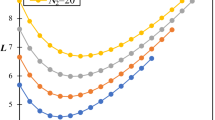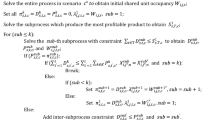Abstract
A cyclic shop is a production system that repeatedly produces identical sets of parts of multiple types, called minimal part sets (MPSs), in the same loading and processing sequence. A different part type may have a different machine visit sequence. We consider a version of cyclic job shop where some operations of an MPS instance are processed prior to some operations of the previous MPS instances. We call such a shop an overtaking cyclic job shop (OCJS). The overtaking degree can be specified by how many MPS instances the operations of an MPS instance can overtake. More overtaking results in more work-in-progress, but reduces the cycle time, in general. We prove that for a given processing sequence of the operations at each machine, under some conditions, an OCJS has a stable earliest starting schedule such that each operation starts as soon as its preceding operations are completed, the schedule repeats an identical timing pattern for each MPS instance, and the cycle time is kept to be minimal. To do these, we propose a specialized approach to analyzing steady states for an event graph model of an OCJS that has a cyclic structure, which can keep the MPS-based scheduling concept. Based on the steady-state results, we develop a mixed integer programming model for finding a processing sequence of the operations at each machine and the overtaking degrees, if necessary, that minimize the cycle time.
Similar content being viewed by others
References
Agnetis, A., “Scheduling No-wait Robotic Cell with Two and Three Machines,” European Journal of Operational Research, Vol. 123, pp. 303–314 (2000).
Agnetis, A. and Pacciarelli, D., “Part Sequencing in Three-Machine No-wait Robotic Cells,” Operations Research Letters, Vol. 27, pp. 185–192 (2000).
Ahmadi, R. H. and Wurgaft, H., “Design for Synchronized Flow Manufacturing,” Management Science, Vol. 40, pp. 1469–1483 (1994).
Baccelli, F. L., Cohen, G., Quadrat, J. P., and Olsder, G. J., Synchronization and Linearity, John Wiley & Sons, New York (1992).
Carré, B. A., “An Algebra for Network Routing Problems,” Journal of Institute of Mathematics and Applications, Vol. 7, pp. 273–294 (1971).
Chaar, J. K. and Davidson, E. S., “Cyclic Job Shop Scheduling Using Reservation Tables,” Proceedings of the 1990 IEEE International Conference on Robotics and Automation, Cincinnati, OH, pp. 2128–2135 (1990).
Crama, Y., Kats, V., van de Klundert, J., and Levner, E., “Cyclic Scheduling of Robotic Flowshops,” Annals of Operations Research, Vol. 96, pp. 97–104 (2000).
Crama, Y. and van de Klundert, J., “Cyclic Scheduling of Identical Parts in a Robotic Cell,” Operations Research, Vol. 45, No.6, pp. 952–965 (1997).
Cuninghame-Green, R. A., Minimax Algebra, Springer-Verlag, New York (1979).
Gaubert, S., Theorie Linéaire des Systèmes dans les Dioïdes, Thèse, École des Mines de Paris, Paris (1992).
Gondran, M. and Minoux, M., “Valeurs Propres et Vecteurs Propres dans les Dioïdes et leur Interprétation en Théorie des Graphes,” Bulletin de la Direction des Études et Recherches, Série C, Mathématiques Informatique, Vol. 2, pp. 25–41 (1977).
Graves, S. C., Meal, H. C., Stefek, D., and Zeghmi, A. H., “Scheduling of Re-entrant Flow Shops,” Journal of Operations Management, Vol. 3, pp. 197–207 (1983).
Hall, N. G., “Operations Research Techniques for Robotics Systems,” Handbook of Industrial Robotics, S. Y. Nof (Ed.), John Wiley & Sons, New York (1999).
Hall, N. G., Kamoun, H., and Sriskandarajah, C., “Scheduling in Robotic Cells: Classification, Two and Three Machines Cells,” Operations Research, Vol. 45, No.3, pp. 421–439 (1997).
Hall, N. G., Lee, T. E., and Posner, M. E., “The Complexity of Cyclic Shop Scheduling Problems,” Journal of Scheduling, Vol. 5, pp. 307–327 (2002).
Hanen, C., “Study of a NP-hard Cyclic Scheduling Problem: The Recurrent Job Shop,” European Journal of Operational Research, Vol. 72, pp. 82–101 (1994).
Hillion, H. P. and Proth, J.-M., “Performance Evaluation of Job-Shop Systems Using Timed Event Graphs,” IEEE Transactions on Automatic Control, Vol. 34, No.1, pp. 3–9 (1989).
Hitz, K. L., “Scheduling of Flexible Flow Shops-II,” Technical Report LIDS-R-1049, Laboratory for Information and Decision Systems, M.I.T., Cambridge, MA (1980).
Kamoun, H. and Sriskandarajah, C., “The Complexity of Scheduling Jobs in Repetitive Manufacturing Systems,” European Journal of Operational Research, Vol. 70, pp. 350–364 (1993).
Karabati, S. and Kouvelis, P., “The Interface of Buffer Design and Cyclic Scheduling Decisions in Deterministic Flow Lines,” Annals of Operations Research, Vol. 50, pp. 295–317 (1994).
Lee, T. E., “Periodic Job Shop Scheduling,” Ph.D. Thesis, The Ohio State University, Columbus, OH (1991).
Lee, T. E., “Stable Earliest Starting Schedules for Cyclic Job Shops: A Linear System Approach,” International Journal of Flexible Manufacturing Systems, Vol. 12, pp. 59–80 (2000).
Lee, T. E. and Posner, M. E., “Performance Measures and Schedules in Periodic Job Shops,” Operations Research, Vol. 45, No.1, pp. 72–91 (1997).
Levner, E. and Kats, V., “A Parametric Critical Path Problem and an Application for Cyclic Scheduling,” Discrete Applied Mathematics, Vol. 87, pp. 149–158 (1998).
Levner, E., Kats, V. B., and Levit, V. E., “An Improved Algorithm for a Cyclic Robotic Scheduling Problem,” European Journal of Operational Research, Vol. 97, pp. 500–508 (1997).
Matsuo, H., “Cyclic Sequencing Problems in the Two-Machine Permutation Flow Shop: Complexity, Worst-case and Average-case Analysis,” Naval Research Logistics, Vol. 37, pp. 679–694 (1990).
McCormick, S. T., Pinedo, M. L., Shenker, S., and Wolf, B., “Sequencing in an Assembly Line with Blocking to Minimize Cycle Time,” Operations Research, Vol. 37, No.6, pp. 925–935 (1989).
Murata, T., “Petri Nets: Properties, Analysis and Application,” Proceedings of the IEEE, Vol. 77, No.4, pp. 541–580 (1989).
Peterson, J. L., Petri Net Theory and the Modeling of Systems, Prentice-Hall, Inc., Englewood Cliffs, NJ (1981).
Ramamoorthy, C. V. and Ho, G. S., “Performance Evaluation of Asynchronous Concurrent Systems Using Petri Nets,” IEEE Transactions on Software Engineering, Vol. 6, No.5, pp. 440–449 (1980).
Roundy, R., “Cyclic Schedules for Job Shops with Identical Jobs,” Mathematics of Operations Research, Vol. 17, pp. 842–865 (1992).
Sethi, S. P., Sriskandarajah, C., Sorger, G., Blazewicz, J., and Kubiak, W., “Sequencing of Parts and Robot Moves in a Robot Cell,” International Journal of Flexible Manufacturing Systems, Vol. 4, pp. 331–358 (1992).
Song, J. S. and Lee, T. E., “Petri Net Modeling and Scheduling for Cyclic Job Shops with Blocking,” Computers and Industrial Engineering, Vol. 35, No.2, pp. 281–295 (1998).
Sriskandarajah, C., Hall, N. G., and Kamoun, H., “Scheduling Large Robotic Cells without Buffers,” Annals of Operations Research, Vol. 76, pp. 287–321 (1998).
Author information
Authors and Affiliations
Corresponding author
Rights and permissions
About this article
Cite this article
Seo, JW., Lee, TE. Steady-State Analysis and Scheduling of Cyclic Job Shops with Overtaking. International Journal of Flexible Manufacturing Systems 14, 291–318 (2002). https://doi.org/10.1023/A:1020911406530
Issue Date:
DOI: https://doi.org/10.1023/A:1020911406530




